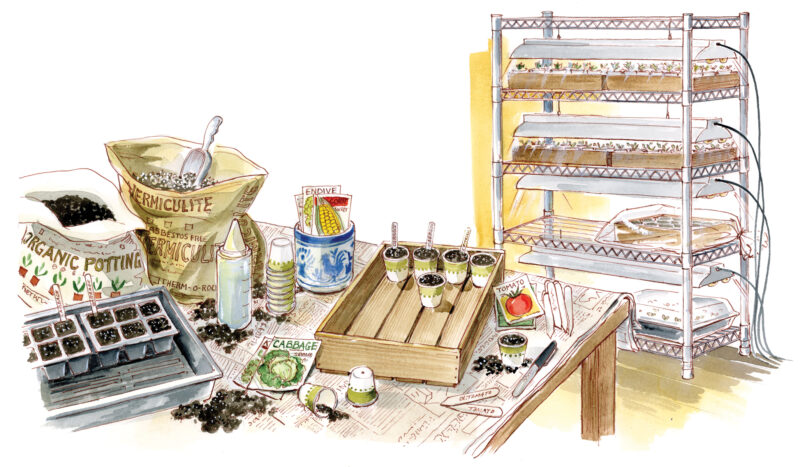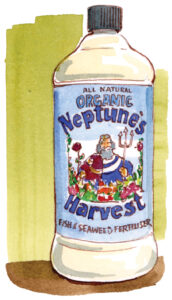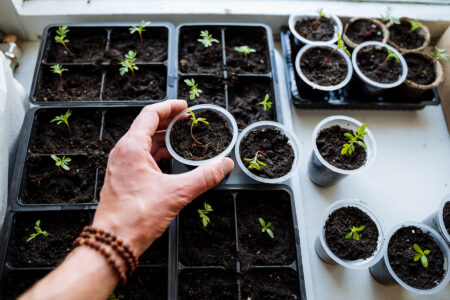Start growing seeds indoors this winter and learn how to grow seeds indoors for spring garden planting.
I began growing my own vegetable seedlings more than 30 years ago, and I still remember my sad first attempts. Many seedlings keeled over and died, and some seeds never germinated at all. Experience has taught me how to prevent these problems, and every year I deepen my garden’s diversity, save money and share favorite varieties with friends by starting seeds indoors. Thousands of superior crop varieties are rarely available as seedlings in garden centers, and the same goes for wonderful culinary crops, such as red celery and seed-sown shallots. If your gardening goal is to fill your table and pantry with an array of homegrown organic food, then starting plants from seed can help you achieve that goal. Starting seeds indoors under controlled conditions, with no aggravation from weeds or weather, allows you to get a prompt start on the season, whether you are sowing onions in late winter, squash in summer or lettuce in early fall. And where growing seasons are short, some crops require an indoor head start to later reach maturity.
How to Grow Seeds Indoors: The Germination Process
All seeds contain specialized cells that mobilize and grow when the germination process is triggered by moisture, temperature and sometimes light. Moisture and stored nutrients energize the embryo, which contains the latent structures for a plant’s root, stem and leaves. Most vegetable seeds that germinate quickly (such as cabbage and tomatoes) enter their dormant state with mature, fully formed embryos. The carrot family is at a disadvantage, however, because most Umbelliferae seeds (think parsley, fennel and dill) need time for their underdeveloped ovaries to grow before they can sprout. Other slow sprouters — spinach, for example — have compounds that inhibit germination in their seed coats. These compounds have to break down in the soil before the root and sprout can burst forth into the world.
Oxygen is vital to the germination process. Until seedlings have leaves to enable them to use solar energy, they rely on the food reserves in the seed combined with oxygen found in the soil to grow new cells. This is why you should always use a light-textured potting medium to start seeds, and why over-watering can cause seeds to rot instead of grow.
Appreciating the hard work that seeds must do during the germination process will likely enhance your seed-starting experience. You can watch time-lapse videos online of fast-growing bean seeds germinating, but watching them in person is even more amazing. The seeds that impress me most are squash. By the time the seedling leaves shed the seed coat, the little plant is already supported by a small mountain of roots.

Seed-Starting Mixtures
From the day they germinate, vegetable seedlings face challenges from fungi and bacteria in water, soil and air. The fewer troublemakers they face, the better they can grow, which is why using fresh seed-starting mix each winter is so crucial. Quality seed-starting mixes are formulated to discourage common soilborne pathogens that cause seedlings to rot, and to retain both water and air with ease.
You can make your own seed-starting mix by using either peat moss or coir as a base, and then blending it with compost that has been heated to 150 degrees Fahrenheit to kill any pathogens and weed seeds. Small amounts of vermicompost can be a beneficial addition when added to a seed-starting mix, but use no more than 10 percent by volume.
As a 2005 study from North Carolina State University revealed, it’s not the precise mixture but what’s on top of the soil that counts most. Differences almost disappeared between commercial organic seed-starting mixtures and various homemade mixtures after all of the seeds were covered with vermiculite instead of a planting medium.
Made from two naturally occurring minerals, vermiculite has unmatched natural talents in seed-starting mixtures: It can absorb and retain several times its own weight in moisture while still holding some oxygen. (Regulations that require regular inspection of processing facilities have addressed concerns about possible asbestos contamination in vermiculite. The Organic Materials Review Institute has approved the use of the Therm-O-Rock brand.)
Sorting Through Seedling Containers
Over the years, I have tried at least half a dozen systems for starting seeds indoors, including a special container divided into cells that fits inside a tray with a translucent dome to retain moisture, and other bells and whistles (capillary mats, water sensors) that eventually ended up in a garage sale because they were more trouble than they were worth. I still use parts of these systems, but in recent years, small paper cups with holes punched in the bottom have become my containers of choice, especially because they disappear into my compost after use. The same can be said for planting cups rolled from newspaper, and for cardboard planting “boxes” made by refolding and stapling discarded food boxes.
I’ve used fancy seed-starting setups I would never use again, and I blame peat pellets for several of my early failures. I have also had seedlings grown in peat pots go into shock when the roots hit the walls of the pot, which never happens in plastic, paper or slick cardboard containers. Egg cartons are too small to use for seed-starting unless you’re working with tiny seeds. Seedlings will grow well in a container that holds 3 to 4 ounces of seed-starting mix, which is one-third to one-half cup. Be sure to punch drainage holes in the bottoms of containers that don’t have holes.
For trays to hold seedling containers, I am moving toward old-fashioned wood flats made from scrap pieces of cedar lumber. The shallow open boxes with one-fourth-inch gaps between the bottom slats look nice indoors under lights; outdoors they don’t blow around in the wind the way plastic trays tend to do. You will also need watertight liners for your flats, because watering from both the top and the bottom is beneficial for young seedlings. You can use plastic flats without drainage holes, shallow plastic pans such as new cat litter pans, or even seldom-used large casserole dishes or serving trays. Using sturdy trays makes a collection of seedlings easy to move, water and fertilize.
If you don’t have scrap wood or if you plan to keep your seedlings in a room where you can’t get the floor wet, you may want to use plastic flats instead of wooden ones. To protect your floor, you can set your containers in flats without any drainage holes. This makes watering the entire flat of containers easier because you just pour water into the flat. If you use this approach, be sure to pour out any excess water after the containers have absorbed as much as they can.
Whatever containers you use, fill them to the top with moist seed-starting mix, and then tap the soil down with your finger to eliminate air pockets (it took me three seasons to learn this trick). Add more mix up to within one-fourth inch from the top. Plant seeds at the depth suggested on the seed packet, and sprinkle the seeds gently and generously with water. When using fresh seed packed for the current season, sow no more than three seeds per container — two is even better. With large seeds, such as squash seeds, plant only one seed per container.
If you have clear plastic domes (sometimes sold with seed-starting flats), use them to retain moisture until the seeds germinate. If you are domeless, cover your flats loosely with plastic wrap, or enclose them in translucent plastic bags. Remove the coverings at the first sign of germination, and then shift your focus to giving the seedlings bright light.

Growing Seeds Indoors: Providing Warmth and Light
Let’s get back to our botany lesson, and to why my first seedlings keeled over. As seedlings break through to the soil surface, they are quickly running out of fuel from the seed and need a new energy source: light. If they don’t get enough light, they are more susceptible to attack by fungi. Window light is usually too weak and directional; veggies need intense overhead light — you need to have a fluorescent light fixture to grow your seedlings.
One popular way to make a light shelf on the cheap is to use a heavy-duty, wire storage shelving unit (the big-box-store price is $65 for a four-shelf unit), and hang shop lights from the undersides of the shelves with wire (see the light shelf illustration in the Image Gallery). Or, you can build something like Mother’s combination bookcase/grow light unit (see our detailed plans in Multipurpose Plant Grow Light Seed Starting Bookcase). For lighting, four-foot-wide fixtures with at least two standard fluorescent tubes are your best choice. Standard tubes are fine for seed starting; you do not need to pay extra for special “grow lights.” Fluorescent fixtures don’t heat up the way incandescent lights do, but they still give off some heat. The light units I use have metal hoods that are flat on top, so I can set newly planted trays there.
Warm room temperatures that rise above 75 degrees for several hours a day will trigger germination in just about any vegetable or herb seed, and seeds will benefit from temperatures that vary by about 10 degrees during the day. This happens naturally if you’re using warmth from a fluorescent light that you turn off at night. You can also rig up bottom heat using an ordinary heating pad placed under a seedling tray. (Special mats for seed-starting sound great, but in my experience the mats die before they earn back their substantial purchase price.)
After seeds have germinated, keep them under lights for 12 to 14 hours a day, and adjust the height of the lights (or the trays) to keep your seedlings very close to them. This is important — keep the seedlings so that they almost touch the light tubes. In late winter, you can grow salad greens to an edible size this way.
Growing Seeds Indoors: Watching the Wonder
A seedling’s first set of leaves is followed by a lull in the action as the seedling switches its power source, develops its first true leaf (or two) and grows a flurry of new roots. Crowded seedlings can be separated and repotted when the first true leaf appears, with tiny seedlings such as celery going into small containers, and larger ones such as cabbage moving to 4-inch pots. For this step, remove the outer tines from a plastic fork and use it to gently float the babes into roomier digs, handling them only by their seedling leaves. After I move seedlings to slightly larger containers, I immediately return them to the position under the lights where they were before. This way, the seedlings must recover from only one stress at a time. At their next watering, I like to give transplanted seedlings a flash dunk in a pail of lukewarm water to eliminate hidden air pockets. If the potting medium settles, you can sprinkle more dry mix around the base of the seedling to help keep it upright.
Any nutrients present in the seed-starting mix will be gone after about three weeks, so your seedlings will need supplemental feeding. After years of using fish emulsion/kelp products, last year I made my own liquid fertilizers and saw excellent results. (Read Free, Homemade Liquid Fertilizers.) I doubled the dilution rate of fertilizer to water for young seedlings, which need only small amounts of nutrients because they are such little plants. As for how to deliver both water and organic fertilizer to young seedlings, you will make little mess using a squirt bottle (dishwashing liquid bottles are great) to water and feed from the top and the bottom. Using room temperature water or water/fertilizer mix, dribble in enough water to lightly dampen the surface if it’s dry, and wait a minute or two to see if water flows through the containers and pools around the bottom. Add more water to the pan holding your seedlings until the water is one-fourth inch deep. Wait 30 minutes, and pour off any liquid that has not been absorbed. The dryness of your indoor air will influence how often you need to water your seedlings, which prefer constant, light moisture around their roots and dry conditions at the surface. Dry containers feel light when you pick them up, so daily weight checks are the best way to find out whether your seedlings need water.

To figure out when to start various crops, check the monthly charts on our What to Plant Now pages for your region. From the beginning, keep a written record of your sowing dates. As the season progresses, go back and add comments when you nail the perfect planting windows for your favorite vegetables and varieties. This information will be invaluable as you expand your garden.
Contributing editor Barbara Pleasant gardens in southwest Virginia, where she grows vegetables, herbs, fruits, flowers and a few lucky chickens.







